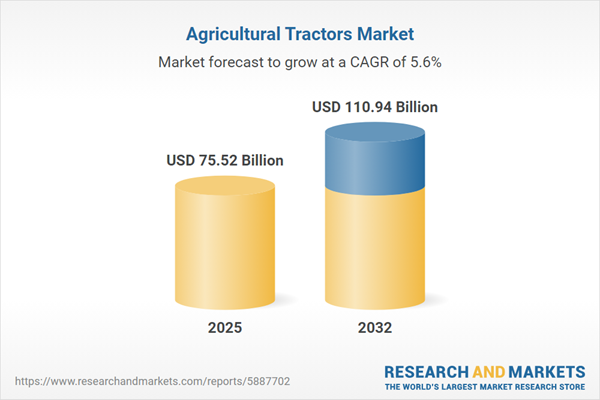Speak directly to the analyst to clarify any post sales queries you may have.
The agricultural tractors market is entering a new phase as agri-businesses and equipment manufacturers embed advanced digital solutions, automation, and precision farming tools into their operations. Senior leaders are prioritizing innovation, regulatory adaptation, and agile business models to drive efficiency and growth as global demand and environmental criteria evolve.
Market Snapshot: Agricultural Tractors Market Size and Forecast
The agricultural tractors market is experiencing robust expansion, propelled by the adoption of smart farming methods and enhanced machine connectivity. As of 2024, the market is valued at USD 71.55 billion, with projections of USD 75.52 billion in 2025 and reaching USD 110.94 billion by 2032. This growth reflects a compound annual growth rate (CAGR) of 5.63%. Continued investment in digital infrastructure and advanced data management is helping to address supply chain challenges. Industry participants are increasingly turning to innovative agricultural workflows to maintain regulatory compliance and build stable, forward-looking growth paths.
Scope & Segmentation in the Agricultural Tractors Market
This report features detailed segmentation designed to support senior decision-makers with actionable insights for procurement, investment, and operational planning in diverse agricultural contexts. Segments analyzed include:
- Engine Power: Informs decisions between high-capacity commercial tractors and specialized equipment, ensuring alignment with both broad-acre and niche cultivation requirements.
- Product Type: Enables comparison among compact, row crop, and utility tractors to match resource allocation with varying field sizes and cropping needs.
- Tractor Type: Supports strategic selection between Four Wheel Drive and Two Wheel Drive configurations, maximizing operational efficiency in differing terrain and usage scenarios.
- Application: Facilitates targeted deployment across broad-acre farming, horticulture, orchard management, and livestock, enhancing adaptability to shifting operational goals.
- Sales Channel: Assesses options from original equipment manufacturers, digital platforms, dealerships, and independent resellers, supporting resilient and flexible procurement pathways.
- Geographic Coverage: Offers analysis of market dynamics, regulatory nuances, and localized practices in North America, Latin America, Europe, Middle East, Africa, and Asia-Pacific to empower region-specific strategies.
- Key Players Covered: Examines the market positions and strategic actions of top manufacturers such as Deere & Company, Mahindra & Mahindra Limited, Kubota Corporation, and CNH Industrial N.V. to facilitate partnership optimization and competitor assessment.
Agricultural Tractors Market: Key Takeaways for Senior Decision-Makers
- Advancements in electrification and automation are boosting equipment adaptability, enabling operators to reduce risk while meeting evolving agriculture standards.
- Telematics and analytics platforms improve predictive maintenance, streamline asset monitoring, and facilitate effective management of widely distributed fleets.
- Agile supply chain redesigns are enhancing responsiveness to both shifting regulations and volatile global market conditions in the agricultural tractors market.
- Collaboration between equipment manufacturers and digital technology specialists is accelerating the development of integrated agronomic platforms, which reinforce both compliance and operational targets.
- Expansion of digital after-sales support is delivering longer asset lifecycle value and strengthening retention and maintenance protocols for fleet-intensive businesses.
- Regional adoption of localized digital solutions is supporting scalable practices and underpins sustainability initiatives attuned to specific agricultural landscapes.
Tariff Impact on Global Supply Chains
Recent tariffs affecting agricultural tractor imports to the United States are prompting strategic supply chain adjustments. Leading organizations are enhancing resilience through supplier diversification and regional assembly capabilities. These initiatives enable rapid adaptation to evolving trade frameworks and reinforce the stability of supply networks.
Methodology & Data Sources
This market assessment draws on primary interviews with manufacturers, distributors, and end-users, integrated with in-depth analysis of sector research, logistics models, and regulatory developments. The methodology provides practical, data-driven guidance, allowing senior executives to make informed planning decisions.
Agricultural Tractors Market: Why This Report Matters
- Enables executives to refine product portfolios, optimize procurement, and support technology investments through structured, evidence-based segmentation and trend evaluation.
- Clarifies compliance obligations and market transitions to support agile adaptation in diverse agricultural equipment sectors.
- Delivers actionable market intelligence to drive sustainable growth initiatives and strategic investment aligned with sector advancement.
Conclusion
This report provides senior decision-makers with reliable, actionable intelligence to navigate emerging challenges and harness evolving opportunities in the agricultural tractors market. It supports proactive strategy formation for sustained operational and competitive strength.
Additional Product Information:
- Purchase of this report includes 1 year online access with quarterly updates.
- This report can be updated on request. Please contact our Customer Experience team using the Ask a Question widget on our website.
Table of Contents
3. Executive Summary
4. Market Overview
7. Cumulative Impact of Artificial Intelligence 2025
Companies Mentioned
The companies profiled in this Agricultural Tractors market report include:- Deere & Company
- Mahindra & Mahindra Limited
- Kubota Corporation
- CNH Industrial N.V.
- AGCO Corporation
- CLAAS KGaA mbH
- SAME Deutz-Fahr S.p.A
- Tractors and Farm Equipment Limited
- Iseki & Co., Ltd.
- Escorts Limited
Table Information
| Report Attribute | Details |
|---|---|
| No. of Pages | 182 |
| Published | November 2025 |
| Forecast Period | 2025 - 2032 |
| Estimated Market Value ( USD | $ 75.52 Billion |
| Forecasted Market Value ( USD | $ 110.94 Billion |
| Compound Annual Growth Rate | 5.6% |
| Regions Covered | Global |
| No. of Companies Mentioned | 11 |









